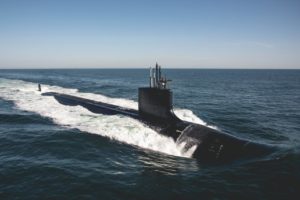Lawmakers are strongly opposing the Navy’s plans to fund eight new ships in fiscal year 2021, including only one Virginia-class submarine, a decrease from 12 in FY ’20.
When the FY ’21 budget request was first released on Monday, asking for eight ships at $20 billion, Chairman of the House Armed Services Subcommittee on Seapower and Projection Forces Rep. Joe Courtney (D-Conn.) immediately denounced the idea as dead on arrival and particularly opposed only building one Virginia-class attack submarine.

“This weak, pathetic request for eight ships – of which two are tugboats – is not only fewer ships than 2020, but fewer ships than the Navy told us last year it planned for 2021,” Courtney said in a statement (Defense Daily, Feb. 10).
The FY ’20 budget funded two Virginia-class submarines.
Courtney’s counterpart on the seapower subcommittee, ranking member Rep. Rob Wittman (R-Va.), also opposed the plan for strategic reasons.
“Simply put, the budget published today does not invest nearly enough in shipbuilding. It is clear to me—and it should be clear to everyone at this point—that we are in a full-scale strategic competition. And, while China is on track to reach a 420-ship Navy by 2035, we are struggling to stay on track with our 355-ship Navy shipbuilding plan,” Wittman said Monday.
Wittman underscored that the Columbia-class ballistic missile submarine program, at a cost of $128 billion, “will be dominating the shipbuilding accounts in the coming years, edging out new projects. A decrease in the shipbuilding account is the opposite direction we need to be going if we are to compete.”
Wittman added that he will work to get the FY ’21 defense authorization bill numbers “back where it needs to be to continue to build and maintain our Fleet; I won’t allow us to lose ground.”
Rep Mac Thornberry (R-Texas), ranking member of the House Armed Services Committee, agreed the ship request is too low but highlighted the Columbia budgetary issue.
“Obviously, we need more ships, and eight ships in a year is clearly not enough. But one thing I’d just remind you all, for the last several years, we have tried to put the Columbia submarine in a separate account, because the problem is when it costs $6 or 8 billion per ship, it eats up all the rest of the shipbuilding,” Thornberry said during a media roundtable on Wednesday.
He noted this year’s request has the first Columbia-class submarine that’s authorized even after it was prefunded for work for years.
“It’s for some odd billion dollars. That’s a big chunk. And I don’t think it’s fair for the Navy to absorb all of that out of their shipbuilding budget,” Thornberry continued.
In Navy budget documents the service is requesting $4 billion in FY ’21 for the first three years of incremental full funding for the first Columbia. It is also requesting another $1.1 billion to continue detailed design efforts, continuous missile tube production, and advanced construction and procurement of major components for the second vessel.
During a budget briefing Monday, Deputy Assistant Secretary of the Navy for Budget Rear Adm. (upper half) Randy Crites noted Columbia is the Navy’s highest priority and expects to start funding the second ship in FY ’24 and start serial production in FY ’26.
The Navy expects the Columbia-class submarines to consume over 20 percent of the shipbuilding account towards the end of the five-year Future Years Defense program. At peak production it will consume over 30 percent of the shipbuilding account.
Crites also said Columbia adds about 146 percent increase in the submarine shipbuilding load and the lower Virginia count was done to “release some pressure as builder performance has slipped and we were trying to de-risk our first Columbia in that.”
Crites noted the new Virginia-class submarines are also adding pressure by adding the Virginia Payload Module and acoustic superiority systems.
However, “that said, we have seen an increase in our industrial performance that improved to point where we believe it’s more about affordability at this point,” he said. “And the ability for us to generate the $2.9 billion to put the [Virginia-class] submarine in back and in game deliberations wasn’t achievable.”
Sen Tim Kaine (D-Va.), a member of the Senate Armed Services Subcommittee on Seapower and from one of two states that builds Virginia-class submarines, said he would push to add back a second Virginia.
“I’m concerned that the President’s budget proposal dramatically cuts funding for Virginia-class submarines. For years, robust funding for these submarines has strengthened our national security and our shipbuilding industry in Hampton Roads. As a member of the Armed Services Committee, I’m going to push hard to reject this budget cut and ensure full funding for two Virginia-class submarines.”
General Dynamics’ [GD] Electric Boat division is the prime Virginia contractor, but Huntington Ingalls Industries’ [HII] Newport News Shipbuilding (NNS) is a subcontractor and they usually split the work on the vessels. Each one makes certain parts of each vessel and then they take turns building the reactor and performing final assembly.
In December, the Navy awarded GD a $22.2 billion contract for nine Block V Virginias that includes an option for a 10th boat. They will be funded through the fiscal years 2019 to 2023 shipbuilding accounts, with deliveries expected from 2025 to 2029 (Defense Daily, Dec. 2).
Navy officials at the time of award said due to GD’s work on the Columbia, NNS will take up more than 50 percent of the Block V attack submarines. The service expects NNS to build six of the Block V submarines and GD will build the other four, if the 10th is chosen. This covers final assembly only, with each shipbuilding splitting the modules they normally build as usual.